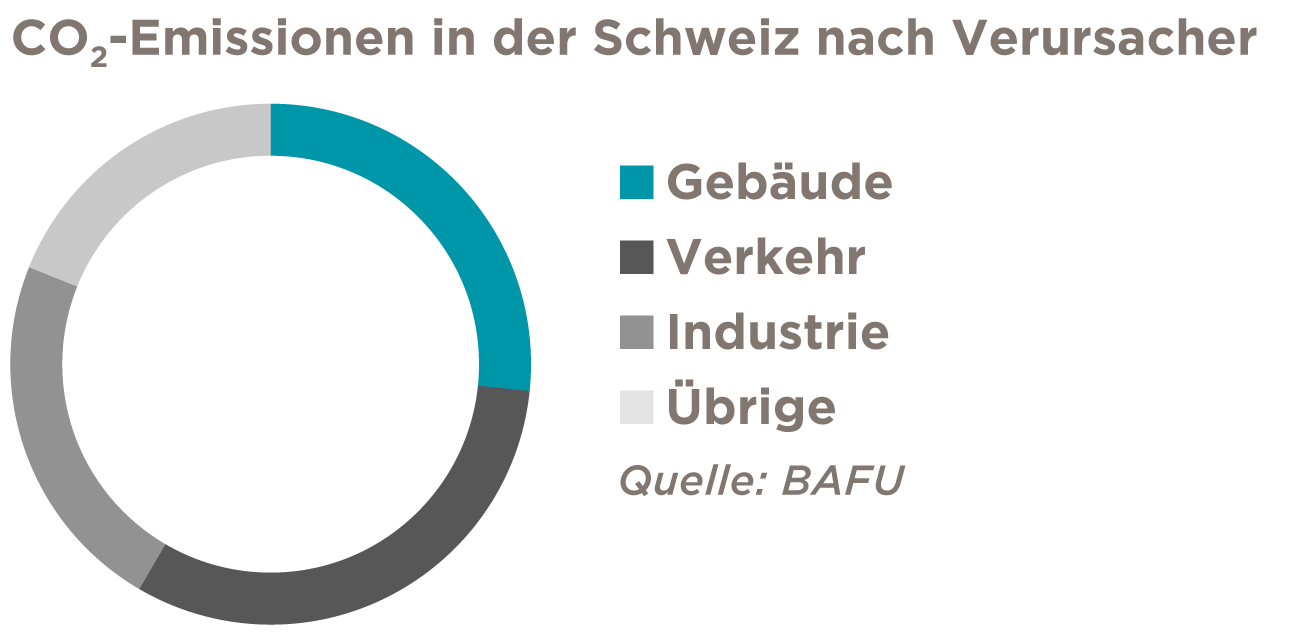Oil and gas heating systems are mainly responsible for CO2 emissions from buildings. The other heat generators are considered CO2-neutral. This applies in particular to district heating and heat pumps. However, wood (renewable) and electricity (produced in Switzerland predominantly CO2-neutral) are also considered CO2-neutral.
Since virtually no oil or gas heating systems are installed in new buildings, new buildings are CO2-neutral by definition. It is therefore all the more worthwhile to take a look at those buildings that are still heated with oil or gas. Older properties are particularly problematic, as they not only usually still use fossil heat sources, but in many cases are also poorly insulated. The pressure on owners is increasing, not least because more and more cantons are implementing the MuKEn 2014.
What does this mean? Do the owners of such properties now have to invest a lot of money without any financial benefit? And do the tenants have to accept higher rents in any case? A study commissioned by the Swiss Federal Office of Energy (SFOE) from the real estate consultancy firm Wüest Partner shows that this does not have to be the case.

The environment benefits in any case
There is no question that the environment benefits from energy-saving renovations if a building is operated in a more environmentally friendly way after an energy-saving renovation. But what conditions must be met so that the owners of the properties and their tenants can also benefit from energy-saving renovations?
This is how owners of rented accommodation benefit
Owners of real estate benefit from energy-efficient refurbishment if they can finance the investment costs through higher rental income and thus increase the market value of their properties.
Rental income typically increases in two steps: First, according to rental law practice, part of the investment can be passed on to the existing tenants. This will definitely increase the income. In many cases this is sufficient to compensate for the investment costs, but often it is not.
However, one should not forget the second step, which is carried out within the framework of the usual tenant turnover: In the case of a new tenant, the landlord has the opportunity to bring rents, which have been lagging behind the market, especially for long-term tenancies, back into line with the market level. Since the gross rent (net rent plus ancillary costs) is decisive for tenants, the landlord can generate higher net income in future with the same gross rent due to lower heating costs. Ultimately, this means that if the rent increases to the market level, the entire investment costs of the energy-efficient refurbishment can subsequently be passed on to the new tenants. The additional income generated by the refurbishment is therefore higher and higher with each change of tenant. The market value effect of refurbishment only fully unfolds when all flats have been newly occupied and rents are back to market level.
How tenants benefit
Tenants benefit from an energy-efficient refurbishment if the heating costs are reduced so much thanks to the refurbishment that this more than compensates for the increase in net rent. The higher the heating costs were before the refurbishment, the greater the likelihood that the gross rent is more favourable after the refurbishment than before the refurbishment. Not to be forgotten, of course, is the fact that tenants can not only benefit financially from refurbishment in certain cases, but will in any case benefit from greater living comfort. For example, new windows not only have a better insulation value but also provide better protection against noise; comfort ventilation significantly improves the quality of living; and a geothermal probe heat pump system not only heats in winter but also offers the possibility of cooling the flat in summer. In addition, more and more tenants attach importance to living in an environmentally friendly property.
This is how owners benefit from owner-occupied residential property
Owners who live in their own four walls can also benefit financially from an energy-efficient refurbishment. This is the case if the savings in heating costs are higher than the financing costs of the refurbishment. The current low interest rate environment offers particularly favourable opportunities for this.
Under what conditions do owners and tenants benefit as well as the environment?
Heating costs: The higher the heating costs prior to refurbishment, the greater the likelihood that the savings from refurbishment will exceed the financing costs of the refurbishment.
Heating replacement: The easier it is to replace a fossil fuel heating system with a non-fossil fuel heating system, the lower the cost of replacing the heating system. In other words, it is helpful if a property to be renovated can be connected to an existing district heating network or is located in a place where the installation of a heat pump is possible without great effort.
Depth of intervention: Often the most financially efficient refurbishments are those which do not provide for the maximum possible depth of intervention. The replacement of an oil or gas heating system with a non-fossil heating system is usually the most important measure. Depending on the situation, this can be accompanied by other measures (new windows, insulation of the basement ceiling, roof or parts of the facade, photovoltaic system).
Subsidies: State subsidies reduce the net investment costs of renovations and benefit both the tenant and the owner. They often tip the scales when it comes to whether a refurbishment is financially worthwhile for the parties involved. The amount of subsidies and the conditions for obtaining them vary greatly from canton to canton and from municipality to municipality.
Conclusion
Energy efficiency improvements will not always have three winners (environment, owner, tenant). However, the study makes it clear that the potential for this is quite large and has probably been underestimated so far.
Source
This contribution is based on the study "Energetic refurbishment. Owners, tenants and the environment as winners", which Wüest Partner drew up on behalf of the Swiss Federal Office of Energy (SFOE). The study is freely available and can be downloaded from the following link.









